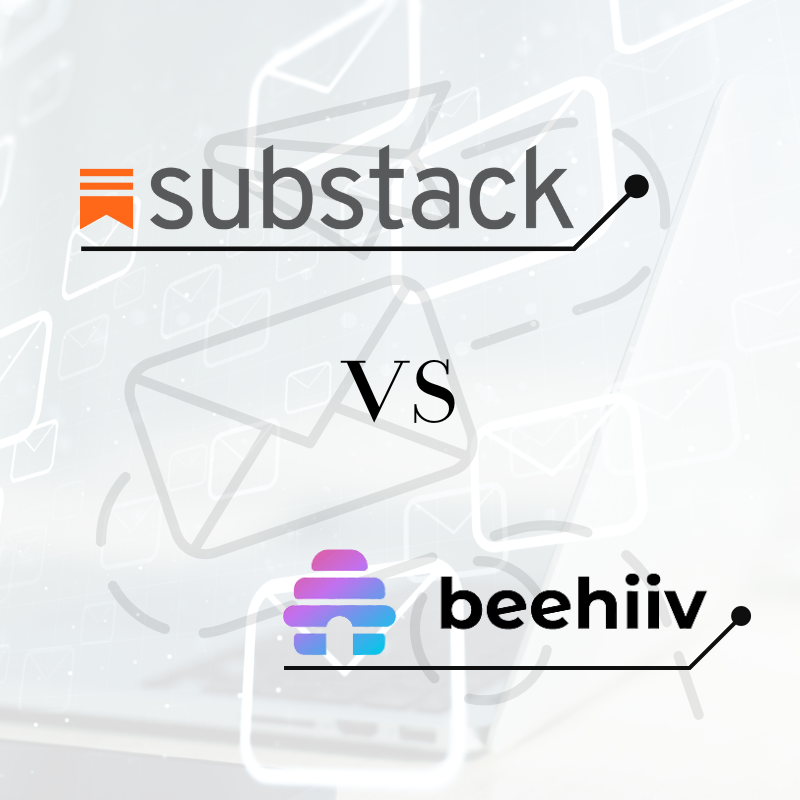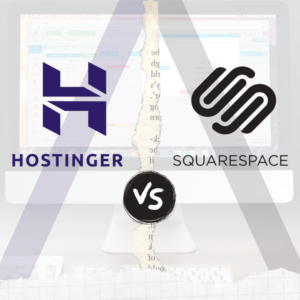Thinking about Substack vs Beehiiv? This 2025 guide breaks down features, pricing, and growth tools to help you choose the best platform for your newsletter.
Table of Contents
Introduction
The creator economy is booming, and email newsletters have become one of the most effective ways to build an audience, share content, and generate recurring revenue. Whether you’re an independent writer, a content creator, or a startup founder, choosing the right newsletter platform is a crucial decision.
Two of the most popular platforms leading this space are Substack and Beehiiv. Both offer powerful tools to help you publish, grow, and monetize your newsletter—but they take very different approaches. That’s where this Substack vs Beehiiv comparison comes in.
In this guide, we’ll break down the key differences between Substack and Beehiiv across important categories like usability, customization, monetization, analytics, and more. By the end, you’ll know exactly which platform aligns best with your goals in 2025.
Platform Overview
Before diving into features and comparisons, it’s important to understand what Substack and Beehiiv actually are and how they position themselves in the newsletter landscape.
Substack is a platform designed for writers who want to build paid or free newsletters with minimal friction. It emphasizes simplicity, allowing creators to focus on writing and building a direct relationship with their audience. Substack handles everything from publishing to payments and email delivery, making it a convenient all-in-one solution.
Beehiiv, on the other hand, is a newer platform built by former Morning Brew team members. It is geared more toward growth-focused creators, offering advanced tools for list management, analytics, and referral programs. Beehiiv aims to give users more control over branding, customization, and growth strategy.
In the substack vs beehiiv debate, your decision will largely depend on whether you prioritize ease of use and community or customization and growth tools.
Ease of Use
When comparing substack vs beehiiv, ease of use is one of the first things creators consider. Both platforms are designed to be beginner-friendly, but they take slightly different approaches.

Substack is known for its simplicity. The sign-up process is quick, and the writing interface feels familiar, like a stripped-down blogging platform. You can publish a post, send it to your subscribers, and manage payments—all without needing any technical knowledge. Substack is ideal for writers who want to get started quickly without distractions.
Beehiiv is also easy to use but offers more advanced options. Its dashboard is clean and intuitive, but it comes with extra features like audience segmentation, growth analytics, and referral tracking. These tools can be incredibly useful, but they might require a slightly steeper learning curve for new users.
In the substack vs beehiiv comparison, Substack wins for minimalism and fast setup, while Beehiiv stands out for users who want more control and scalability as they grow.
Design and Customization
Design flexibility is a key factor when choosing between substack vs beehiiv, especially if you want your newsletter to reflect your brand identity.
Substack offers a clean, minimalist layout with limited design options. You can change basic elements like your logo, accent color, and header image, but the overall structure remains the same across all newsletters. This keeps things simple but may feel restrictive for creators looking for more visual control.
Beehiiv provides more customization tools. You can tailor the look of your newsletter with custom themes, adjust layout elements, and even use custom domains without extra fees. Beehiiv also allows for more branding options on signup pages and websites, which is useful for creators building a unique presence.
In the substack vs beehiiv debate, Substack keeps it minimal and consistent, while Beehiiv gives you more creative freedom to design and personalize your newsletter.
Monetization Options
Monetization is a major consideration for creators comparing substack vs beehiiv. Both platforms support ways to earn from your newsletter, but they approach it differently.
Substack was built with paid subscriptions in mind. It lets you easily set up a paywall, offer monthly or yearly plans, and accept payments through Stripe. You can also send free and paid posts to different segments of your audience. Substack takes a 10 percent cut of your earnings, which is something to factor in if you plan to scale.
Beehiiv does not charge any commission on your revenue. While it doesn’t offer built-in paywalls for individual newsletters, it supports monetization in other ways. You can run ads, offer sponsored content, and use affiliate links. Beehiiv also recently introduced Boosts, a paid newsletter discovery tool where creators can earn revenue through newsletter promotion.

If you’re still exploring how different models of monetization work in digital content, this guide on monetization strategy from Product School is a helpful resource. It covers key concepts like freemium, subscription, and ad-based models that align with how both Substack and Beehiiv operate.
In the substack vs beehiiv comparison, Substack is better for creators focused on paid subscriptions, while Beehiiv gives you more flexible options for monetizing through advertising and partnerships.
Analytics and Performance Tracking
Understanding how your newsletter performs is essential to growing and engaging your audience. In the substack vs beehiiv comparison, analytics is one of the areas where Beehiiv clearly aims to stand out.
Substack provides basic analytics. You can see open rates, click-through rates, subscriber growth, and basic post engagement metrics. While this is enough for many independent writers, it lacks more detailed insights that some growing newsletters may need.
Beehiiv offers more advanced analytics. It includes detailed performance dashboards with open and click rates, subscriber sources, growth trends, and even cohort analysis. You can also create audience segments based on behavior, which helps tailor your content and improve targeting over time.
If analytics is a top priority in your substack vs beehiiv decision, Beehiiv offers a more robust toolkit for data-driven creators, while Substack keeps it simple and straightforward.
Audience Growth Tools
One of the biggest differences in the substack vs beehiiv comparison is how each platform helps you grow your audience. While both offer tools to attract subscribers, Beehiiv puts a stronger focus on growth and discoverability.
Substack includes built-in recommendations. When someone subscribes to a newsletter, they’re often shown other similar newsletters to follow. This feature helps writers grow through Substack’s network of creators. However, outside of this, the platform offers limited tools to actively grow your subscriber list.
Beehiiv was built with growth in mind. It offers a robust referral program where you can reward subscribers who refer others. Beehiiv also has tools like Boosts, which lets you promote your newsletter to other creators’ audiences in a paid discovery format. These features are particularly useful for newsletters aiming to scale quickly.
If you’re focused on growth in the substack vs beehiiv decision, Beehiiv gives you more tools to attract and convert new readers.
Deliverability and Email Infrastructure
Email deliverability plays a major role in how reliably your newsletter reaches your subscribers’ inboxes. In the substack vs beehiiv comparison, both platforms are designed to handle the technical side of email delivery, but there are key differences in how they manage infrastructure and reputation.
Substack handles deliverability behind the scenes. It uses its own sending domains and reputation, which means all users share the same infrastructure. While this keeps things simple, it also means you don’t have control over sender reputation or authentication methods like SPF, DKIM, or DMARC. Substack generally delivers reliably, but some users may experience occasional issues with promotions or spam filters.
Beehiiv takes a more advanced approach. It allows users on higher-tier plans to use custom sending domains, which improves branding and gives you more control over deliverability. Beehiiv also provides tools to monitor performance and configure email authentication settings, which can help improve inbox placement rates over time.
In the substack vs beehiiv debate, Substack focuses on simplicity, while Beehiiv gives creators more control over email delivery and sender reputation.
Pricing Plans
Pricing can be a deciding factor when comparing substack vs beehiiv, especially for creators at different stages of growth. Both platforms offer free options, but their cost structures are quite different.
Substack is free to use, but it charges a 10 percent commission on all paid subscriptions. This means you only pay when you earn, making it ideal for creators who want to start without any upfront costs. However, as your revenue grows, the fees can add up quickly. Substack has no monthly subscription fees, and most features are available to all users.
Beehiiv uses a tiered pricing model. It offers a free plan with core features, but advanced tools like referral programs, custom domains, and in-depth analytics are only available on paid tiers. Beehiiv does not take a cut of your revenue, which can be more cost-effective in the long term, especially for high-earning newsletters. Paid plans start with a flat monthly fee, giving creators predictable costs.
When it comes to pricing in the substack vs beehiiv comparison, Substack is better for low-risk entry and simplicity, while Beehiiv offers more value as your newsletter scales.
Integrations and API Access
Integrations and access to APIs are important for creators who want to connect their newsletter with other tools like CRMs, analytics platforms, or automation workflows. In the substack vs beehiiv comparison, Beehiiv offers a clear advantage in this area.
Substack has limited integrations. It is designed as a standalone platform and does not offer a public API. While you can connect Substack to a custom domain and embed forms on websites, advanced integrations with tools like Zapier, analytics software, or external email platforms are not supported. This works fine for creators who prefer simplicity but can be limiting for those looking to automate or expand.
Beehiiv provides much more flexibility. It offers direct integrations with tools like Zapier, allowing users to connect their newsletters to thousands of apps. Beehiiv also supports webhooks and gives access to a public API, which is valuable for more advanced users or teams that want to build custom workflows.
In the substack vs beehiiv comparison, Beehiiv stands out for its modern infrastructure and developer-friendly tools, while Substack focuses more on an all-in-one experience without external dependencies.
Community and Network Effects
Community features and network effects can make a big difference in how easily your newsletter gets discovered and shared. In the substack vs beehiiv comparison, both platforms offer unique advantages, but they serve different types of community growth.
Substack has a built-in network of writers and readers. It features a discovery feed, recommendations, and a subscriber activity system that encourages cross-promotion between newsletters. When someone subscribes to one newsletter, they often see suggestions for others, which can help creators grow organically within the platform’s ecosystem.
Beehiiv focuses less on a shared community and more on giving individual creators the tools to build their own. While it doesn’t have a centralized discovery system like Substack, Beehiiv’s referral tools, custom domains, and growth features empower creators to grow their audience independently. This approach gives more control but less exposure from a network effect standpoint.
So in the substack vs beehiiv comparison, Substack provides stronger built-in community benefits, while Beehiiv offers more control for creators building from scratch or with an external audience.
Support and Documentation
Reliable support and clear documentation can save time and reduce frustration when setting up or managing a newsletter. In the substack vs beehiiv comparison, both platforms offer support, but they differ in availability and depth.
Substack provides email support and a basic help center with articles covering common questions. The documentation is straightforward but limited in scope. There is no live chat, and response times can vary. While it’s usually enough for casual users, creators with more advanced needs might find it lacking.
Beehiiv offers more structured support. It includes a detailed knowledge base, responsive email support, and live chat for users on higher-tier plans. The platform also publishes blog posts and guides to help users get the most out of its tools. For users looking for hands-on guidance or troubleshooting, Beehiiv tends to be more accessible and comprehensive.
In the substack vs beehiiv evaluation, Substack keeps support simple, while Beehiiv provides more extensive resources and faster assistance, especially for growing teams or advanced users.
SEO and Web Presence
A strong online presence helps creators reach new audiences beyond their subscriber list. In the substack vs beehiiv comparison, both platforms allow you to publish web-based versions of your newsletters, but there are differences in how they handle search engine visibility and customization.

Substack newsletters are automatically published to a public web page, which means your posts can be indexed by Google. However, customization is limited. You can’t use a custom domain unless you apply and are approved, and there’s no control over metadata or advanced SEO settings. This can make it harder to fully optimize your content for search engines.
Beehiiv gives you more control over your web presence. All posts are automatically published online, and you can use your own custom domain on any paid plan. Beehiiv also allows for basic SEO configuration, such as meta titles and descriptions. This makes it easier to build a searchable, branded site around your newsletter content.
If you’re planning to use a custom domain or create a standalone website for your newsletter, it’s also worth choosing the right hosting provider. Here’s a helpful comparison of SiteGround vs GoDaddy on Journey to Cash that breaks down performance, pricing, and support options.
When it comes to SEO and visibility in the substack vs beehiiv discussion, Beehiiv offers more flexibility and branding options, while Substack provides a simpler but more limited approach.
Who Should Use Substack vs Beehiiv?
Choosing the right platform depends on your goals, experience, and how much control you want over your newsletter. In the substack vs beehiiv comparison, each platform serves different types of creators.
Substack is a great fit for individual writers, journalists, and creators who want a simple, all-in-one solution. If you’re focused on writing and building a paid subscriber base without worrying about design or technical details, Substack offers an easy way to get started. It’s especially appealing if you value community features and want to grow through recommendations within the platform.
Beehiiv is better suited for creators, teams, or startups looking for more advanced tools and customization. If you care about branding, analytics, referrals, and integrations, Beehiiv provides more flexibility and scalability. It’s ideal for growth-focused newsletters that want to build an audience using data-driven strategies and have more control over their web presence.
In short, use Substack for simplicity and writing-first workflows, and choose Beehiiv if you want advanced features and room to scale.
Conclusion: Which Newsletter Platform Is Better in 2025?
When it comes to substack vs beehiiv in 2025, the better platform really depends on your needs as a creator. Both offer powerful tools, but they are built with different priorities in mind.

Substack is ideal for those who want to start quickly, keep things simple, and focus on writing and connecting with readers. Its built-in discovery features, minimal setup, and user-friendly approach make it perfect for solo writers and those who want a low-maintenance way to monetize their content.
Beehiiv, on the other hand, is built for growth. With better customization, advanced analytics, referral tools, and more control over your branding, it’s a strong choice for creators who want to scale, experiment, and fully own their platform.
In the end, there is no one-size-fits-all answer in the substack vs beehiiv comparison. If you value simplicity and community, Substack might be your best bet. If you’re looking for long-term growth and flexibility, Beehiiv is likely the better choice.





